Baby Jane and the
Rockabyes
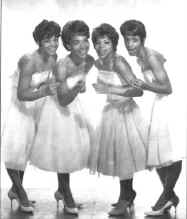
Baby Jane and the Rockabyes, 1963
Left to Right: Yolanda Robinson, Yvonne
DeMunn, Madelyn Moore, Estelle McEwan
Although their career as hit makers
was brief and money not always forthcoming, like so many other
young people in the music business in New York during the 50s and
60s, Baby Jane and The Rockabyes had their shot at stardom and
had fun doing it in the process.
The DeVaurs (1958-1961)
Brenda Carrow
Yvonne DeMunn
Paula Hutchison
Estelle McEwan |
The Rockabyes (1962-1966)
Yvonne Demunn
Estelle McEwan
Madelyn Moore
Yolanda Robinson |
|
|
The group that became Baby
Jane & The Rockabyes started in The Bronx, New York in 1958,
when schoolgirls Estelle McEwan, Yvonne DeMunn, Paula Hutchinson
and Brenda Carrow decided to form a group in their Morrisania
neighborhood.
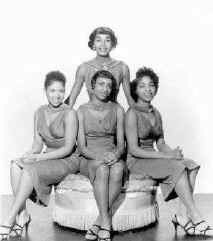
The DeVaurs,1959
(L-R) Paula Hutchinson, Estelle McEwan, Yvonne DeMunn
Standing is Brenda Carrow
All the girls were sophomores at
the now historic Morris High School. Estelle and Yvonne became
friends after Yvonne's family had moved to The Bronx from Queens.
Estelle brought Paula into the group and Brenda came because she
was friendly with Paula. The quartet called themselves The
DeVaurs, part of the name coming from Yvonne's last name. The
group began singing locally, and it wasn't long before they
caught the attention of their classmates at Morris High.
Hearing of a talent contest the
girls went down, auditioned, and won. The DeVaurs' prize was a
recording contract with D-Tone Records, a small, independent
label out of Williamsburg, Brooklyn.
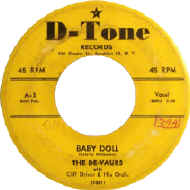
The first session held in
Manhattan. Cliff Driver conducted the session. Driver had an
association in the music business with Hy Weiss, owner of Old
Town Records. The DeVaurs' recorded one of Estelle's songs
"Baby Doll" with Paula on lead. Their efforts were
supported by disc jockey Hal Jackson who interviewed the group on
his show. Despite the support and the favorable onset, 'Baby
Doll' failed to make any impact on local radio and eventually
disappeared.
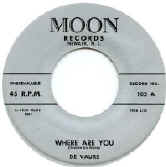
The DeVaurs kept up their local
live appearances. In 1959, the group recorded for producer Donald
Shaw's Moon label of New Jersey. It was here that they
recorded "Where Are You".
The group's New Jersey label and
distribution pushed the record area. It was featured in the
top 20 on WNJR in the New York/New Jersey area in 1959.
By the start of the new decade,
the members of The DeVaurs were married and working day jobs in
addition to singing. Brenda's interest in the group had
waned and she left the group in 1961. Madelyn Moore, another
friend from the neighborhood was asked to join the group.
Changes continued with the departure of Paula, who moved to
Brooklyn. Despite the loss of group members, The DeVaurs
continued singing as a trio for a short time.
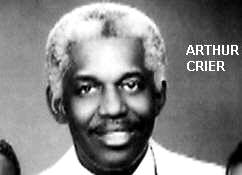
Morissania native Crier, a
Singer, songwriter producer, Arthur Crier was fellow recording
demos Morrisania native Arthur Crier. Arthur had been
a member of The Five Chimes and The Mellows during the 1950s.
Arthur now sang bass in The Halos. '. In addition to singing,
Arthur was also writing songs and recording demos. He took note
of the group's talent and asked The DeVaurs if they were
interested in cutting demos for songwriters and singing backup at
recording sessions. It was through this association that the
group met singer Yolanda Robinson. She was added to The DeVaurs,
once again forming a quartet. In addition to Arthur and
songwriter Carl Spencer, The DeVaurs worked for Jerry
Leiber and Mike Stoller, Teacho Wiltshire and Bert Berns at Trio
Music.
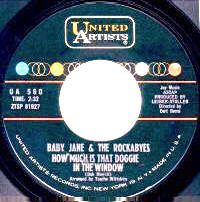
In 1962, Phil Spector had
success recording a version of the Disney classic 'Zip-A-Dee
Doo-Da' in a bump-and-grind style with a lowdown twangy guitar
break. This almost unrecognizable rendition by Bob B. Soxx and
The Blue Jeans burned up the airwaves, making it into the top 10.
Convinced that this was a mine for a potential hit, Leiber and
Stoller copied the style for a version of the Patti Page chart
topper, 'How Much Is That Doggie In The Window'. When the song
was presented to the DeVaurs, they were aghast at being asked to
record this pre-teen ditty. However, the group agreed to recorded
the song with the simplistic vocal arrangement, augmented with
Carl Spencer's bass on the bridge. '…Doggie' was slated for
release on United Artist Records, then the home of Leiber and
Stoller's independent productions, after their falling out at
Atlantic Records. When the records were pressed, The DeVaurs were
shocked to find that they had a new name. Supposedly, the name of
Baby Jane & The Rockabyes grew out of the popularity of the
Joan Crawford/Bette Davis film blockbuster, 'Whatever Happened To
Baby Jane'. Shortly after its release, 'Doggie' climbed to the
middle of the Top 100, stalling at #69, but making a respectable
showing in several local markets.
Leiber and Stoller they decided
to try again with a with a Drifterish sounding ballad, with tempo
changes for the choruses. 'All I Want To Do Is Run' was a more
daring attempt at another pop hit, so maybe that's why Leiber and
Stoller elected to release this single under a new name, the
Elektras. At the session Bert Berns directed and co-wrote the
song and Teacho Wiltshire arranged. The single made noise in New
York, but nothing more than that.
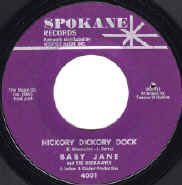
Ellie Greenwich and Jeff Barry,
wrote another song culled from the title of another nursery
rhyme, "Hickory Dickory Dock". This single was
released on the small Spokane Records, then distributed by
Florence Greenberg's Scepter complex. Although this single didn't
chart, "Hickory Dickery Dock" made local play lists
around the New York/New Jersey area.
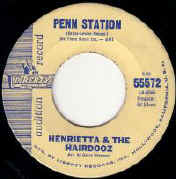
With no success with their
follow-up singles, Leiber and Stoller eventually parted ways with
Baby Jane & The Rockabyes. In the middle of all this, Yolanda
had agreed to record a series of singles with songwriter/producer
Ed Silvers. She hadn't informed her group mates, which caused
quite a stir, since they were now obligated to sing under yet
another name, Henrietta and The Hairdooz. Under this name, the
group released three singles with Liberty Records in late
1963 and early '64. The last single, "I Love Him"
is credited only to Henrietta, because the girls, protesting
another change of their identity.
Arthur Crier had been managing
The Rockabyes, as well as a few other acts like Barbara English,
Savannah Smith and his sister Shirley's group, The Darlettes.
Arthur decided to add the role of producer for The Rockabyes as
well. The group recorded for two of Arthur's associates, Gene
Redd, a former singer with The Fi-Tones Quintet and
singer/songwriter Sammy Fain. Gene produced two mild soul songs
for the group in late 1964, billing them as The Lullabyes and
placing them with Dimension Records, now a few months beyond its
prime, having been sold by Don Kirshner. Unfortunately, "My
Heart Cries For You" did not add anything to Dimension's
increasingly shrinking presence as a hit-making label.
The last bright spot in the
career of Baby Jane & The Rockabyes came in 1966, when Crier
and his production partner, Al Cleveland, produced the group for
the Jubilee subsidiary, Port Records. The style chosen for Baby
Jane & The Rockabyes was a solid dance groove made popular by
Motown Records. 'Dance Till My Feet Get Tired' inspires dancers
to do just that. Although the dance tune didn't take off,
it marked Arthur and Al's introduction to Motown's Berry Gordy,
who hired them as staff writers and producers. Also, Madelyn was
married and pregnant and not able to make personal appearances.
Savannah Smith took her place at shows. Yolanda also left the
group in 1967. The remaining ladies changed the group's image by
adding singer Billy Guy to the lineup. This configuration
continued to make public appearances for about a year before
breaking up in 1968.
Yvonne and Billy came together
to resume their singing careers during the 1970s, forming The
Starr-Blair Affair. In addition, Yvonne and Billy joined in
marriage. Their versatile band performed in numerous clubs in the
New York area, singing everything from pop to Rhythm & Blues
to standards. The successful live act prospered throughout the
late 1970s, until Billy's untimely death, after which Yvonne
decided to give up performing and concentrate on her family.
After giving up singing, Madelyn
Moore settled into domestic life in The Bronx. Sadly, Estelle
McEwan passed away in the 1970s. Savannah Smith, whose real name
is Arnetta Livingston, has kept up with her singing, joining a
revived configuration of The Darlettes in 1999. The whereabouts
of Yolanda, Paula and Brenda are unknown. Today, with her
children grown and her singing days behind her, Yvonne works for
the New York Housing Authority. Even though she decided to retire
from singing, Yvonne has nothing but fond memories of making a
living with her passion for writing and singing songs.
Though their career as hit
makers was brief and money not always forthcoming, like so many
other young people in the music business in New York during the
50s and 60s, Baby Jane and The Rockabyes had their shot at
stardom and had fun doing it in the process. This is no tall
tale, but a true telling of how penetrable the Rock & Roll
music industry was in its infancy.







